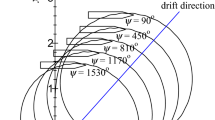Abstract
In order to achieve safe navigation, it is important to be able to understand and calculate the effects of an external force on the maneuvering behavior of a ship. This paper analyzes the course stability and yaw motion of a ship traveling under steady wind conditions. A course stability criterion and approximate formulae for the yaw motion in steady wind, including the aero/hydrodynamic force derivatives for the ship, are derived. To confirm the reliability of the criterion and formulae, they were used to investigate a pure car carrier in steady wind. The results of this investigation revealed that course instability appears in the head and following wind directions, mainly under the influence of aerodynamic derivatives with respect to the yaw restoring forces. However, this course instability can be reduced by applying steering control. For winds ranging from head winds to beam winds, yaw oscillation appears when the period is relatively long and the damping is small. The analytical formulae derived here can be used to gain a better understanding of ship maneuvering behavior in steady wind.










Similar content being viewed by others
Notes
In this paper, \(T_1^{\prime}\) indicates the smaller of the two coefficients (\(T_1^{\prime}, T_2^{\prime}\)) in Nomoto’s model [4].
References
Ogawa A (1969) Calculations on the steered motion of a ship under the action of external forces (part 1)—coursekeeping and turning of a ship in uniform wind and flow. J Soc Nav Archit Jpn 126:107–120 (in Japanese)
Spyrou K (1995) Yaw stability of ships in steady wind. Ship Technol Res 42(1):21–30
Eda H (1968) Low-speed controllability of ships in wind. J Ship Res 12(3):181–200
Nomoto K, Taguchi T, Honda K, Hirano S (1957) On the steering qualities of ships. Int Shipbuild Prog 4:354–370
Isherwood RM (1972) Wind resistance of merchant ships. RINA Trans 115:327–338
Yoshimura Y, Nagashima J (1985) Estimation of the manoeuvring behaviour of ship in uniform wind. J Soc Nav Archit Jpn 158:125–136 (in Japanese)
Yoshimura Y (1986) Mathematical model for the manoeuvring ship motion in shallow water. J Kansai Soc Nav Archit Jpn 200:41–51 (in Japanese)
Fujiwara T, Ueno M, Nimura T (1998) Estimation of wind forces and moments acting on ships. J Soc Nav Archit Jpn 183:77–90 (in Japanese)
Fujiwara T, Ueno M, Nimura T (2001) An estimation method of wind forces and moments acting on ships. In: Proc Mini Symp on Prediction of Ship Manoeuvring Performance, Tokyo, Japan, 18 Oct 2001
Author information
Authors and Affiliations
Corresponding author
About this article
Cite this article
Yasukawa, H., Hirono, T., Nakayama, Y. et al. Course stability and yaw motion of a ship in steady wind. J Mar Sci Technol 17, 291–304 (2012). https://doi.org/10.1007/s00773-012-0168-z
Received:
Accepted:
Published:
Issue Date:
DOI: https://doi.org/10.1007/s00773-012-0168-z




